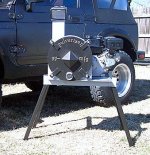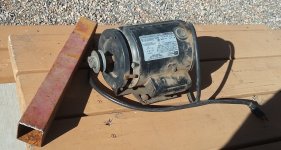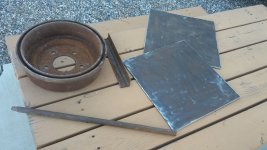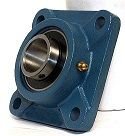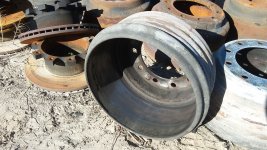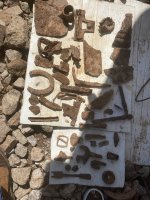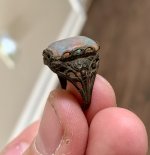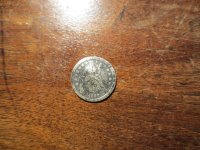Grumpie
Full Member
- Oct 23, 2016
- 205
- 136
- Detector(s) used
- Nokta fors gold plus, tesoro lobo supertraq, Makro gold racer, Nokta Makro Anfibio
- Primary Interest:
- Prospecting
Great thread, guys. Wish I had the fab experience and skills to do builds like this. Very nice work.
I'll try to describe my setup and maybe post some pics later.
Mine is setup to run at home. Runs by 1.5 hp 220V elec motor with pulleys and belt at about 3000 rpm to the shaft. I believe tip speed on the chains is about 70 mph. It could be run in the field with a genny, but I enjoy scrounging ore afield and milling on occasion at home. The neighbors think I'm nuts, of course, and that's part of the fun.
I have the same crusher as in post #8. I believe the guy that made it is Richard Hansen.
It's a smaller unit, about a 8" drum. Mine doesn't have the welded chute added onto the output like in the photo. That output corridor (arm) is unique on these little chain flails and seems to work well - ends up being a wind tunnel on the output. I have a 10 mesh stainless screen on my output which feeds a 1 1/2" clear flexible hose (spa hose). That hose is routed directly into a 15 gallon enclosed tub that has a vent port outlet on one side with a long length of vacuum hose that is hooked up to a small shop vac. Obviously, I run the shop vac while crushing. With this setup, there is virtually no dust in my milling area (outside). The shop vac is venting fine dust some 30 feet away. I still wear a dust mask and eye and hearing protection.
My particular chain flail uses two separate lengths of chain in loops, not as single strands as is more common. The bottom link of the loop is the only one that will get worn and it is providing a good sweep as it rotates. Of course, the chains can be flipped for longer wear, but I had a welder add on what Jair recommended above… that is, cut-to-fit pieces of hardened steel cutting blades on the two striking faces. This works very well and the wear seems to be moderate. So far, I have only milled 200 lbs of material on each side of the links and it looks like the faces will take several hundred lbs more before needing replacement. Before, I was using the mill without the cutting blades and wear on the links was problematic.
The other thing I'm doing differently than before is I'm using a small 3"x4" jaw crusher (Golden Manf. Merlin, Or) as a primary. This knocks everything down to 1/4" minus and not only allows a more steady feed rate into the impact mill, but greatly reduces the wear on the chain flails (or hammers). The problem is that inexpensive jaw crushers are hard to come by and usually aren't portable. They are fantastic tools for crushing, though.
I believe someone wanted to know whether the chain flails need to be balanced. I'm experiencing excessive vibration while using my impact mill. I believe this is due to the custom work I had done on the flails. I need to unbolt the flails and weigh each one. Then, I'll have the welder get the weight balance of them closer. I had to put 100 pounds of weight on my stand to keep the whole thing from wanting to scoot. That extra vibration probably helps with output, but will certainly kill the bearings prematurely.
Overall, I'm happy with this setup. Milling and recovery of values from hard rock is not something I thought I'd get into, but after enough years of small-scale placer mining, it just seemed to happen naturally. I can't say I'll be doing a whole lot of it, but it's something different to experiment with between placer mining.
Personally, I wouldn't bother milling and processing anything on a micro-scale like this unless gold values were at least a couple oz/t. Most of the ore I have milled produces gold in the 100 minus mesh size. This is a pita, but the values are extremely high, so it's worth the effort.
Screening the milled ore by hand is the worst part. I screen to four fractions using 30, 50 and 100 mesh screens. 30 mesh plus gets a fast panning. 30-50, 50-100, and 100 minus gets run through two simple cleanup sluices fed with small, vibratory feeder. Sluices are just regular ribbed mat in the first, and California sluice (his business is for sale) drop riffle in the second, using 750 gph 12 volt recirc pump. 85% of the 100 minus gold is captured on the first run. The larger fractions, of course, behave a little better.
Whole setup probably cost about $1,500. I run both crushers off the same elec motor.
Light snow falling outside, so thought this would be something worth sharing.
Happy crushing.
I would say a balanced shaft is critical to keep vibration at a minimum. If you have a equal amount of chain on one side compared to the opposite and the plates that are welded to the shaft that the chains are attached to are aligned correctly, parallel and the welds are not globed on in excess on one side compared to the other you should be fine. Attention to detail when putting together the internals is critical.
Sometimes less is better expecially in this case.
I'm putting together one myself, but the shaft will be cut and formed by a machinest just for this purpose. Lol
Last edited:



 -
- 

